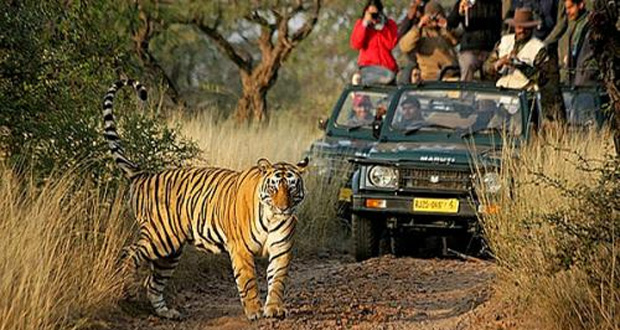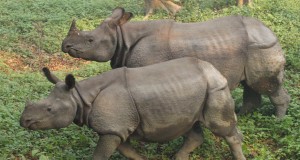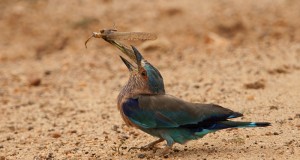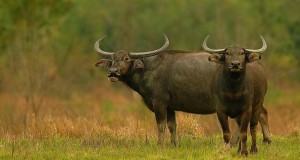Dudhwa National Park, which emerged from a struggle against a welter of vested interests, is even now threatened by a surge of ever-increasing demographic pressure. A viable pattern of coexistence between humans and other forms of life is urgently required if the latter are not to be overwhelmed.
The North Kheri Forest Division, as the area in which the park is located was previously called, has the finest quality sal (Shorea robusta) in India; the Forest Department, in its eagerness to exploit this commercially, opposed the establishment of the park, oblivious of their simultaneous responsibility of protecting India’s wildlife. “Sportsmen” too were reluctant to surrender the right to kill the so-called game animals that lived there in substantial numbers. The surrounding population protested that they would be denied building materials for their homes and grazing areas for their cattle. 
Thanks to the avid and virtually singlehanded lobbying by the present writer and the firm conviction of a conservationminded prime minister, the late Mrs Indira Gandhi, the division was declared a wildlife sanctuary in 1965 and a National Park in 1977, despite opposition and objections. Barasinqha Country: Dudhwa National Park, covering 190 sq miles (490 sq km) of grassland and woodland, consists, as mentioned earlier, mainly of sal forest. The Neora river and the bed of the Soheli which is dry before the confluence run along the southern edge, between which and the sal forest to the north lie the grasslands that are the barasingha’s or swamp deer’s preferred habitat, about 40 sq miles (100 sq km) of which have been preserved in the park. The rest have been taken over by cultivation.
By far the largest numbers of barasingha, for which the park is best known, occur in the Sathiana and Kakraha blocks, in the southwest and southeast sectors respectively, which together comprise some 17-18 sq miles (4500 hectares). Sathiana is the wetter area, much of it being inundated for at least short periods during the monsoon season.
Grasses are generally tall and coarse, sometimes forming dense thickets that are difficult to penetrate even by elephant. Several swampy depressions, which contain water for all or most of the year, cross the land from north to south, and numerousrhinoceros, made possible as a gift to conservation by the late Indira Gandhi. Two males and five females have been translocated from Assam and Nepal, and are thriving. An increase in their numbers with such a small initial population may well be restrained by tiger predation on their young, and severely threatened by the entirely spurious and vicious trade in its remains by humans. The introduction of a further number of colonizers is therefore necessary.
Wild elephant, previously only seasonal visitors, were driven, during the 1960s and 70s, by massive habitat destruction in Nepal, to cross over to Dudhwa, and a herd of over 30 animals spent nearly 10 years in the park. As wide-ranging animals they have since returned to Nepal, to remnants of their habitat still surviving in Sukla Manta and Bardia Wildlife Reserves across the border. Further visits would be welcome, especially as the magnificent herd bull is by computation more than 11 feet (four meters) tall at the shoulder.
Other animals seen in Dudhwa in fair to dwindling numbers are sloth bears, raters , civets, jackals, fishing cats, jungle cats and leopard cats. Among the deer, in addition to the barasingha, are the sambar, the chital (considered the handsomest deer in the world), the hog deer and the barking deer. Also wild pigs and the blue-bull, our largest antelope.
In winter, basking on the sandy banks of the Soheli-Neora river, running along the southern boundary of the park, the snubnosed crocodile or mugger may be seen. Otters are fairly common, as also pythons and monitor lizards.
Avian Variety: Birdlife is prolific, and one ornithologist has said that Dudhwa could establish its claim to fame even merely on account of its owls and storks. Among the night birds of prey are the great Indian horned owl, the forest eagle owl, the brown fish owl, the tawny fish owl, the dusky horned owl, and the brown wood owl. The collared scops owl and the jungle owlet are among the more vociferous of the lesser varieties. Apart from the sarus crane, there are black-necked storks, white-necked storks, black storks, painted storks, white storks, open-billed storks and adjutant storks. Raptors are of infinite variety, and occasionally species of hawks and eagles appear which tax the talent of the most gifted of ornithologists. Six vultures, including the cinerious, are present at times. Among the bustards, the great Indian bustard has disappeared, while the Bengal and the Sikh florican overlap, in greatly diminished numbers. The swamp partridge has a transitional habitat, with the black and the gray partridges occupying higher grasslands and sandy soils. Among the colorful birds are varieties of woodpeckers, orioles, pittas, kingfishers. minivets, flycatchers and sunburns ; also hornbills, bulbuls, prinias, chats and warblers, whose innumerable species were obviously enumerated by a birdman with a sardonic twist of humor.
Migratory birds are plentiful, especially waterfowl, and as Dudhwa is close to the Himalayan foothills, various species stop over in the course of their migration to the plains in winter. However, national as well as international pressures are becoming manifest. The white ibis has vanished, and the ethereal trumpeting of the fighting demoiselle cranes is heard no more.
Dudhwa National Park is one of India’s most exciting and vigorous wildlife reserves, but also, at the same time, one of the most vulnerable. Looking into the crystal bowl of the future, two alternatives are discernible. A restricted world of wild nature cordoned off from the exploitation of humans, or an uneontained human population explosion gathering for a Gadarene rush into a polluted ocean.
NEW HOMES FOR THE RHINOCEROS Five hundred years ago the Indian onehorned rhinoceros had a much wider dis-. tribution than at present and included much of the Indo-Gangetic plain, Assam, Bengal, Burma and Thailand. By the early 1980s it was restricted to a few pockets. With over 70 percent of the world’s population restricted to a single park (Kaziranga), it was long felt necessary to reduce the possibility of disaster to the species through disease or flood by establishing new populations.
The .primary needs of the rhino are a well-watered habitat with plenty of food and permanent water holes. One of the few areas of suitable habitat within the rhino’s previous range was Dudhwa. The rhino was present in the area until the latter half of the 19th Century. Other possible sites are Champaran in Bihar, Intanki in Nagaland and Lalighabri Sanctuary in Arunachal Pradesh.
The article alongside reports the translocation already achieved in Dudhwa National Park and stresses the need for increasing the number of transferees if the population is to be viable.





